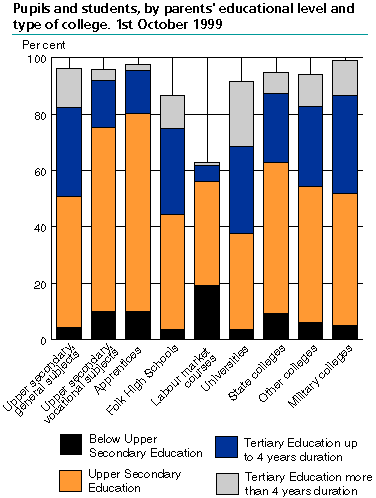Content
Published:
This is an archived release.
Steady increase in the number of students
Just over 191 600 students were enrolled in higher education in autumn 1999. This is an increase of almost 7 500 students, or about 4 per cent compared with the year before.
The largest increase in the number of students has taken place at colleges, where the number of students has increased by more than 9 700. On the other hand the four universities saw a combined decline of 2 800 in the number of students, or around 4 per cent.
There were 223 400 pupils in upper secondary schools and folk high schools in the autumn of 1999. Compared with the autumn of 1998, there has been a varying decline in the number of pupils enrolled in all programmes at the upper secondary level. The decline in general studies was 1 per cent, while it was 2 per cent in vocational programmes. On the other hand, the number of pupils in other upper secondary programmes has not changed much, only a small reduction has taken place. For apprentices, the decline was 3 per cent compared with the year before. There were 3 per cent fewer pupils at folk high schools in 1999 than in 1998 and all of 42 per cent fewer pupils on labour market courses. The rapid decline in pupils in labour market courses is related to the situation in the labour market.
Social background
Of the students enrolled at universities and scientific colleges, 23 per cent had parents with a post-graduate degree, and 31 per cent had parents with a shorter education of up to four years. Only one in three had parents with an upper secondary school education. For the state colleges the corresponding percentages were 8 and 25 per cent, while over half had parents with an education at the upper secondary school level. There are also large differences in the social backgrounds of pupils in general and vocational programmes in upper secondary school. Around 2 per cent of the apprentices had parents with a post-graduate level education, while two out of three had parents with an upper secondary school level education.
Increasing female percentage
The percentage of women in higher education is still increasing, and is now nearly 59 per cent. This tendency is mirrored at most institutions. The exception is a few universities and colleges with mostly technological or economic degree programmes, such as the Norwegian University of Science and Technology (NTNU), Norwegian School of Economics & Business, Narvik College and the Norwegian School of Management BI, where men are in the majority. At military colleges, more than nine out of 10 students are men.
The gender distribution in upper secondary education and at folk high schools has changed from autumn 1996 to autumn 1999. While there hasn't been any change in the female percentage in general studies programmes, there has been an increase of 3 percentage points in vocational programmes. At folk high schools the female percentage among pupils has risen by all of 5 percentage points from 1996 to 1999. The same is reflected among apprentices and in other upper secondary programmes, where the female share in 1999 was 31 and 52 per cent, an increase of 5 and 8 percentage points. There have been smaller changes in the gender distribution in labour market courses, an increase of 1 percentage point.
Tables:
- Table 1 Pupils and students by parents educational level and type of school. 1st October 1999. Per cent
- Table 2 Pupils and students, by age, gender and type of college. 1st October 1999
- Table 3 Pupils in folk high schools and upper secondary education by gender and type of school. October 1996-1999
- Table 4 Apprentices and pupils under the Upper Secondary Education Act by age and county of residence. 1st October 1999
- Table 5 Pupils under the Upper Secondary Education Act by type of education and gender. 1st October 1999
- Table 6 Apprentices and pupils under the Upper Secondary Education Act by age, gender and class level. 1st October 1999
- Table 7 Students, by gender, type of college, ownership and educational institution. 1st October 1997-1999
- Table 8 Students, by age and type of college. Absolute figures and percentages. 1st October 1999
The statistics is published with Upper secondary education.
Contact
-
Statistics Norway's Information Centre
E-mail: informasjon@ssb.no
tel.: (+47) 21 09 46 42

